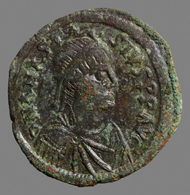October 27, 2016 – During excavations on the Upper Agora in the ancient city of Ephesos in western Turkey, archaeologists of the Austrian Archaeological Institute (OeAI) of the Austrian Academy of Sciences (OeAW) made an exciting discovery in summer 2016.
View of the Upper Agora with the place where the hoard was discovered. Photo: ÖAW-ÖAI/Niki Gail.
160 coins were recovered from a crevice in a wall and likely were originally deposited in a bag that no longer is preserved. The find is of particular importance for the dating of the Upper Agora. The obvious find circumstances prove that the administrative center of Ephesos – once characterized by fabulous buildings with political and religious functions – had lost its purpose by the 520s AD and that the building material of the public buildings had been released for despoliation.
Coin from the time of emperor Anastasius I (491-518). Photo: ÖAW-IKAnt/Nikolaus Schindel.
Despite the difficult circumstances that plagued the Austrian archaeologists in Ephesos this year, exceptional discoveries were also possible. The discovery of hoards is seldom in Ephesos. Although the city of Ephesos – located along the western coast of modern day Turkey – was one of the largest cities of antiquity, the Austrian Archaeological Institute (OeAI) of the Austrian Academy of Sciences has found only very few hoards in its 120 years of leading the excavations in Ephesos. A coin hoard describes multiple coins deposited, buried, or sunk at the same time and in most cases were hidden as a way of protecting them from others. This year such a hiding spot was discovered by Austrian archaeologists during excavations on the Upper Agora, the urban center of Ephesos.
Crevice of wall. Photo: ÖAW-ÖAI/Niki Gail.
The coins were possibly deposited in a bag made of organic material that no longer is preserved. 160 coins were recovered from a narrow crevice in the wall of the portico (Stoa) of the square.
View of the portico located on the south side of the Upper Agora. Photo: ÖAW-ÖAI/Niki Gail.
The discovery of this hoard is a particular stroke of luck for research because now an often debated question can be answered, namely when did the Upper Agora lose its function. Archaeologist and excavation director of Ephesos Dr Sabine Ladstätter: “The discovered coins date the end of the imperial administrative center of the city that was characterized by splendid buildings with political and religious functions. The bag can only have been placed in the crevice from above signalizing that at this point the portico had already been largely removed. Therefore, we can assume that by the 520s the Upper Agora was already in ruins and the formerly resplendent buildings were the source of building material. The urban center had moved to the area surrounding the harbor where building elements from the Upper Agora are located.”
Coin from the time of emperor Hilderic (523-518). Photo: ÖAW-IKAnt/Nikolaus Schindel.
The coins themselves also provide valuable information about life in the ancient city. Dr. Nikolaus Schindel, numismatist at the OeAW, is dealing with the analysis of the coins: “The composition of the hoard indicates close commercial ties of Ephesos with North Africa even following the conquest of the Vandals. This is the only possible explanation for the circumstance that coins with the portraits of the kings Thrasamund and Hilderic could circulate alongside those of the Byzantine emperors Anastasius and Zeno.”
The excavations were conducted as part of a project by the University of Regensburg under the direction of Dirk Steuernagel and in collaboration with the OeAI. The aim of this project – financed by the German Research Foundation (DFG) – is the study of the history and function of the Upper Agora.
You can find the website of the Austrian Archaeological Institute here.
However, it seems doubtful whether the Austrian Archaeological Institute will continue their excavation in Ephesos or not as we reported recently.
During her travel to Turkey Ursula Kampmann visited Ephesos, too. Read her impressions here.











